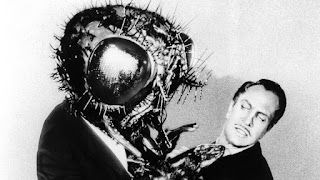 |
| Mutant flies are scary things, as victims of The Fly can attest. Happy Hallowing! 20th Century Fox/The Kobal Collection at Art Resource, NY |
Topics: Biology, Humor, Nobel Laureate, Nobel Prize, Science Fiction
During the whole of a dull, dark, and soundless day in the autumn of the year, when the clouds hung oppressively low in the heavens and the shades of evening drew on, a sense of insufferable gloom fell on geneticist Michael O’Connor. He was looking at decaying embryos of fruit flies in his lab that had mutations in genes known as disembodiment and ghost, mummy and haunted, shroud and phantom, spook and shadow. There was an iciness, a sinking, a sickening of the heart—an unredeemed dreariness of thought which no goading of the imagination could torture into aught of the sublime, when it came to him with a power that lies beyond our depth. “These are Halloween genes!” he declared, trembling at the realization that he had coined a catchy scientific phrase. And from that shadowy day forward in the late 1990s, so they have been known far and wide.
OK, that’s not exactly what happened, and apologies to Edgar Allan Poe. But O’Connor, who heads the genetics department at the University of Minnesota in Minneapolis did dub disembodiment, ghost, and their creepy, ghoulish kin “Halloween genes.” In what became an iconic image—in his lab at least—one of the postdocs, Marcela Chavez, drew a fly on a witch’s broom. A native Spanish speaker, Chavez remembers cracking everyone up at one lab meeting when a misspelling in her presentation read “Hallowing” genes.
The identification and naming of the genes themselves came out of a massive screen for mutants in the fly embryonic genome that led to the Nobel Prize in 1995. One of the winners, Ed Lewis, was a friend of O’Connor’s. “Ed was a big Halloween person,” O’Connor says. “He’d spend all year making his Halloween costumes.” A fan of Belgian surrealist René Magritte, Lewis would dress as characters from his paintings, including the man in a leopard print caveman garb holding a barbell in Perpetual Motion and the man with a birdcage chest and straw hat in The Therapist.
Science: A gory tale behind the origin of ‘Halloween genes’, Jon Cohen
Comments